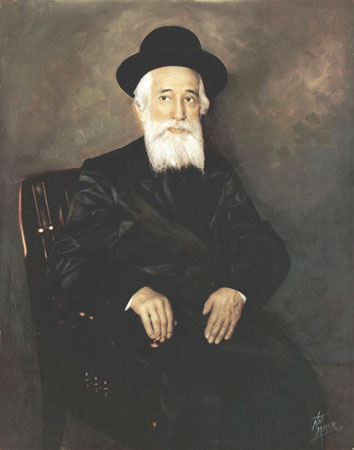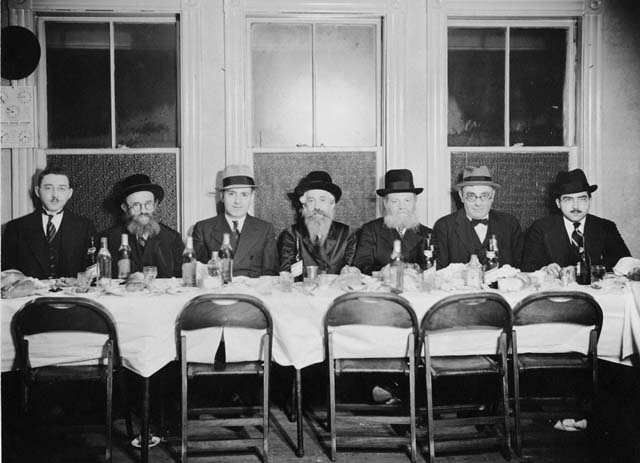THE ZVILLER REBBE

|
GRAND RABBI JACOB ISRAEL KORFF: THE ZVILLER REBBE |
|
On occasion when the Grand Rabbi's own financial situation was not at best, close friends would advise him to curtail his philanthropic endeavors. To this the rabbi more than once queried, "You're not asking me to curtail my light and heat and personal food bills, but you say I should cut down on help to other human beings. To help others in need is just as important as to have for one's self the necessaries [sic] of life." [1]
After Adele was married and she realized that her father was having a particularly tough year because he had given away all his money, she approached him at the High Holidays, gave him a honey cake, and like his many followers, she asked for his blessing. Like the others, Adele also left some money. This infuriated Jacob. He took the money and sent it to charity immediately, right in front of Adele.[2]
 |
|
|
Click here to listen to Adele Korff Gass explain her family’s view of materialism. (Recorded November 9, 1992 in Winthrop, Massachusetts) |
Among the countless incidents told about Grand Rabbi Korff's magnanimous heart and charitable soul are many that record the part the rebbe played in aiding those who came to Boston as refugees from the Holocaust. One particular occasion was well documented:
“One Friday morning it was noted by members of his family that he was missing from home. He had not left word about going anywhere, and as the hours dragged on, members of the family became quite concerned about his safety. After almost a whole day of anguish, a fleet of taxis suddenly pulled up in front of his home and some thirty-nine foreign-looking men, women, and children emerged from the vehicles. Neighbors and passersby were astounded by this entourage of men with flowing beards, boys with long pe'oth--all typical east European Hasidic Jews, who had been brought by Grand Rabbi Korff to his home directly from the ship as they landed in Boston. None of them had any place to spend the Sabbath and all were reluctant to continue their travels on the Sabbath to their final destinations in New York and Chicago. Food and sleeping quarters were arranged in Grand Rabbi Korff's home and chapel, and once again he carried out one of his many mitzvot to help his fellow human beings.”[3]
 |
|
Left to right Baruch Korff, ?, Max Gass (Jacob Korff’s son-in-law), Grand Rabbi Jacob Korff, ?, Samuel Gass (Max’s father), Rabbi Samuel I. Korff |
Grand Rabbi Jacob Korff, followed the tradition of the Baal Shem Tov and began his day by daavening (praying) before or around sunrise, He donned two sets of tefillin, Rashi and Rabbenu Tam. He would have first put on his tallis (prayer shawl) and Rashi tefillin, daavened to Ashrei, and then removed the Rashi and put on Rabbenu Tam (except on Rosh Chodesh, where there is a slight difference) and finished daavening. Following tradition, he would have studied after davening, still wearing the Rabbenu Tam tefillin. It is conceivable that he might have removed the Rabbenu Tam tefillin after daavening, eaten breakfast (The rebbe’s typical breakfast consisted of tea, one egg, and a piece of toast) and then donned the tefillin again to study.
Adele Korff Gass described a typical day in her father’s life in America after he finished davening and studying:
“The people would start coming to consult with him. Later, the rabbis would arrive. My father usually met with people in the study. The room looked like a big dining room and contained a table large enough to seat at least 12. There was a couch near the table so my father could lie down when he tired--he had a heart condition. Although the room had curtains, there were no rugs and no decorations on the wall. Books were scattered all over--the couch, on the chairs, on the table. There were no books on secular topics, only Jewish writings. My father also used a small study with a roll top desk and a telephone.
"Intrigued by my father's constant studying, l once asked, 'Papa, how much can you learn?' He replied, 'The more you learn the less you know."'
Shabbos (Sabbath) at the Korffs was a joyous occasion. On Friday evening the candles were lit before going to shul. At the end of services while still in the synagogue, the singing of Sholom Aleichem[4] began and was continued on the way back from shul, and was concluded while walking around the Shabbos table. Then came daavening Minchah and Kabbolas Shabbos. The reciting of kiddush (blessing over wine) and ha-motzi (blessing over bread) came later. The Korffs and their guests would then eat a sumptuous meal. Shabbos hymns, presumably Zmiros, were sung during and throughout the meal
Adele described the scene:
"Sometimes the men danced around the table. Afterward, they discussed the weekly Torah portion and the Talmud. On Saturday after shul, eating again became a focus. The meal consisted of seven things to taste. We would have eggs with onion; liver with onions; onion with herrings, and more. That was the custom. There was always cholent (a slow-cooked stew of meat and vegetables) that had simmered overnight on the stove.
"Each Friday without fail, there was a certain man who came to our house. I would give him some change and his weekend meal--challah, fish, and some canned goods. My father had told us children, 'if somebody puts a hand out, if you haven't got a dollar give him fifty cents. If you haven't got fifty cents, give a quarter. But never, never shame anybody by turning them away.'
|
|
|
The giant challah on the table indicates that this is a special occasion, such as a wedding, not a typical Shabbat dinner. (The use of a camera is another indicator.) Rabbi Korff is the second from the left.) |
"One day after the man had finished his meal and left the house, l removed his plate from the table and found two bank books beneath it. On close inspection I discovered that the man had saved a substantial amount of money. I was furious and showed the books to my father. He ordered me to replace the books and the plate, and to pretend I had never seen them. Shortly after, the man returned to the table, clandestinely retrieved his belongings, and departed apparently with the belief that his secret was safe. Under my father's direction never to shame a person, l continued to serve the man his weekly Shabbos meal but I didn't load it with extras as I had in the past. Soon after, the man stopped coming."
Celebrating Betty’s Wedding






|

Rabbi Jacob Korff and his eldest daughter Adele Gass at the wedding of Jacob’s next eldest daughter, Betty Korff Berkowitz. Etta Korff is behind them.
[1] 1952 Press Release.
[2] It is possible that Adele may have misremembered part of this incident. The tradition on the eves of Yom Kippur and Rosh Hashanah, and especially on erev Yom Kippur morning, is for the rebbe to distribute pieces of honey cake along with a blessing to those who line up for it. Since the rebbe’s family often had sponge cake and honey cake in the home, Adele may have confused the common event of her serving her father honey cake with the Yom Kippur tradition.
[3] Ibid.
[4] Shalom Aleichem: Shalom aleichem, malachei hasharet, malachei elyon, mi melechmalchei ham- lachim, Hakodosh Baruch Hu. (Peace be yours, angels of peace. Angels of the most high. Angel of the King who is King of Kings. The holy blessed One.)